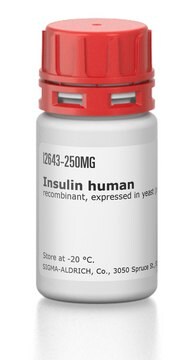N0636
Nicotinamide
BioReagent, suitable for cell culture, suitable for insect cell culture
Synonyme(s) :
Acide nicotinique amide, Acide pyridine-3-carboxylique amide, Vitamine PP, Vitamine B3
About This Item
Produits recommandés
Source biologique
synthetic (organic)
Niveau de qualité
Gamme de produits
BioReagent
Pureté
≥98% (HPLC)
Forme
powder
Poids mol.
Mw 122.12 g/mol
Technique(s)
cell culture | insect: suitable
cell culture | mammalian: suitable
Couleur
white
Pf
128-131 °C (lit.)
Solubilité
water: soluble 50 mg/mL, clear, colorless
Chaîne SMILES
NC(=O)c1cccnc1
InChI
1S/C6H6N2O/c7-6(9)5-2-1-3-8-4-5/h1-4H,(H2,7,9)
Clé InChI
DFPAKSUCGFBDDF-UHFFFAOYSA-N
Informations sur le gène
human ... PARP1(142) , SIRT2(22933)
Vous recherchez des produits similaires ? Visite Guide de comparaison des produits
Catégories apparentées
Description générale
Application
Actions biochimiques/physiologiques
Mention d'avertissement
Warning
Mentions de danger
Conseils de prudence
Classification des risques
Eye Irrit. 2
Code de la classe de stockage
11 - Combustible Solids
Classe de danger pour l'eau (WGK)
WGK 1
Point d'éclair (°F)
302.0 °F - closed cup
Point d'éclair (°C)
150 °C - closed cup
Équipement de protection individuelle
dust mask type N95 (US), Eyeshields, Gloves
Certificats d'analyse (COA)
Recherchez un Certificats d'analyse (COA) en saisissant le numéro de lot du produit. Les numéros de lot figurent sur l'étiquette du produit après les mots "Lot" ou "Batch".
Déjà en possession de ce produit ?
Retrouvez la documentation relative aux produits que vous avez récemment achetés dans la Bibliothèque de documents.
Les clients ont également consulté
Articles
Oxidative stress is mediated, in part, by reactive oxygen species produced by multiple cellular processes and controlled by cellular antioxidant mechanisms such as enzymatic scavengers or antioxidant modulators. Free radicals, such as reactive oxygen species, cause cellular damage via cellular.
Oxidative stress is mediated, in part, by reactive oxygen species produced by multiple cellular processes and controlled by cellular antioxidant mechanisms such as enzymatic scavengers or antioxidant modulators. Free radicals, such as reactive oxygen species, cause cellular damage via cellular.
Notre équipe de scientifiques dispose d'une expérience dans tous les secteurs de la recherche, notamment en sciences de la vie, science des matériaux, synthèse chimique, chromatographie, analyse et dans de nombreux autres domaines..
Contacter notre Service technique






